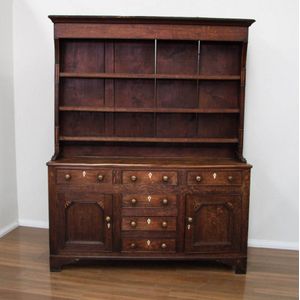George II Oak Dresser from Ross House
You must be a subscriber, and be logged in to view price and dealer details.
Subscribe Now to view actual auction price for this item
When you subscribe, you have the option of setting the currency in which to display prices to $Au, $US, $NZ or Stg.
- Cornice - The upper section of a high piece of furniture such as a bookcase, wardrobe or cabinet that sits immediately on the main structure. The cornice is usually decorated with a variety of architectural mouldings, worked either with a moulding plane or, from the later 19th century, by machine. The front and side of the cornice are mitred together, strengthened by glue blocks, and the back is generally a simple dovetailed rail to hold the structure together. Cornices are generally, though not always, fitted separately to the piece and are held in place either by screws sunk into the top board or by wooden corner blocks. A pediment may sit above the cornice, but sometimes the terms cornice and pediment are used interchangeably.
- Oak - Native to Europe and England, oak has been used for joinery, furniture and building since the beginning of the medieval civilisation. It is a pale yellow in colour when freshly cut and darkens with age to a mid brown colour.
Oak as a furniture timber was superceded by walnut in the 17th century, and in the 18th century by mahogany,
Semi-fossilised bog oak is black in colour, and is found in peat bogs where the trees have fallen and been preserved from decay by the bog. It is used for jewellery and small carved trinkets.
Pollard oak is taken from an oak that has been regularly pollarded, that is the upper branches have been removed at the top of the trunk, result that new branches would appear, and over time the top would become ball-like. . When harvested and sawn, the timber displays a continuous surface of knotty circles. The timber was scarce and expensive and was used in more expensive pieces of furniture in the Regency and Victorian periods. - George Ii - George II (1683 - 1760) was King of Great Britain and Ireland from 1727 until his death in 1760.
- Provenance - A term used to describe the provable history of an antique or work of art, and thus an additional aid to verifying its authenticity. Provenance can have an inflating effect on the price of an item, particularly if the provenance relates to the early settlement of Australia, a famous person, or royalty. Less significant are previous sales of the item through an auction house or dealer.
- Block Feet - Block feet are usually found on square or sometimes tapered legs. Although the basic block foot is square on all sides, there are variations including a tapered block foot, moulded block foot and carved block foot.
This item has been included into following indexes:
Visually similar items

An early 18th century oak and elm dresser with pierced scalloped cornice above open shelves, the base with six drawers, and enclosed cupboards; shaped feet. Width 161 cm

A Directoire walnut bookcase, later 19th century, an elegant plain two door glazed bookcase with diamond inlaid panels to the lower register, fluted stiles to the edges and raised on tapering conforming legs, with timber shelves to the interior, height 135

A George III 18th century oak Welsh dresser, the raised back with pediment and frieze, above three moulded shelves, the base with three frieze drawers, above three further drawers, flanked by panel door cupboards. 200 cm high, 162 cm wide, 45 cm deep.

A Louis XVI style tulipwood marquetry bookcase, circa 1900, with a white marble top and pierced brass gallery above a full length glazed door flanked by panelled side cupboards, inlaid with musical trophies to the upper register and with quarter veneer pan
